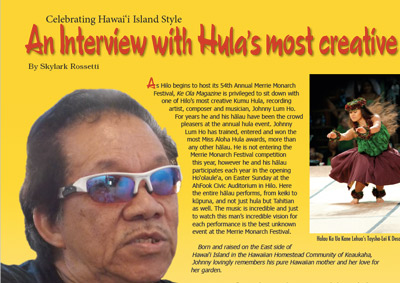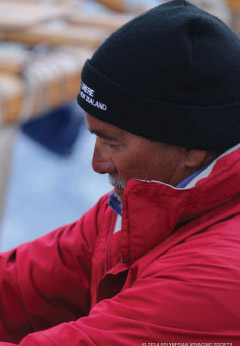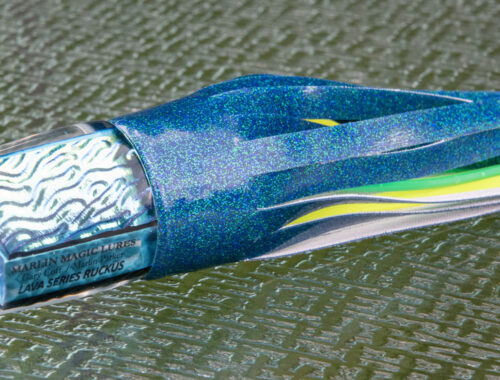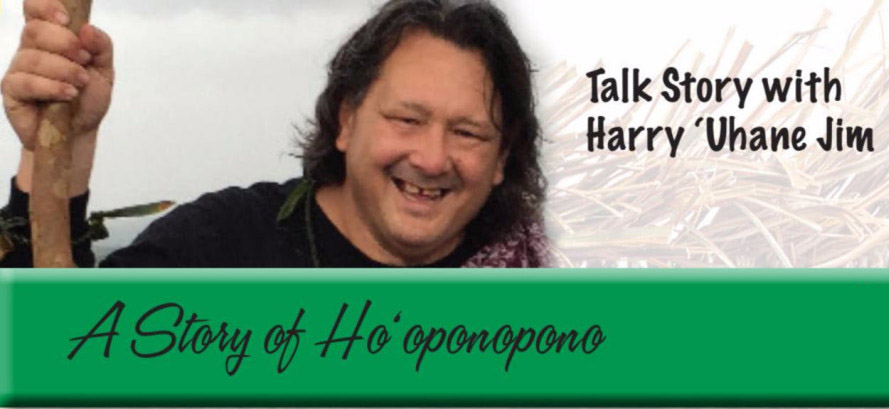Interview with Hula’s Most Creative Kumu Hula Johnny Lum Ho
By Skylark Rossetti
 As Hilo begins to host its 54th Annual Merrie Monarch Festival, Ke Ola Magazine is privileged to sit down with one of Hilo’s most creative Kumu Hula, recording artist, composer and musician, Johnny Lum Ho. For years he and his hālau have been the crowd pleasers at the annual hula event. Johnny Lum Ho has trained, entered and won the most Miss Aloha Hula awards, more than any other hālau. He is not entering the Merrie Monarch Festival competition this year, however he and his hālau participates each year in the opening Ho‘olaule‘a, on Easter Sunday at the AhFook Civic Auditorium in Hilo. Here the entire hālau performs, from keiki to kūpuna, and not just hula but Tahitian as well. The music is incredible and just to watch this man’s incredible vision for each performance is the best unknown event at the Merrie Monarch Festival.
As Hilo begins to host its 54th Annual Merrie Monarch Festival, Ke Ola Magazine is privileged to sit down with one of Hilo’s most creative Kumu Hula, recording artist, composer and musician, Johnny Lum Ho. For years he and his hālau have been the crowd pleasers at the annual hula event. Johnny Lum Ho has trained, entered and won the most Miss Aloha Hula awards, more than any other hālau. He is not entering the Merrie Monarch Festival competition this year, however he and his hālau participates each year in the opening Ho‘olaule‘a, on Easter Sunday at the AhFook Civic Auditorium in Hilo. Here the entire hālau performs, from keiki to kūpuna, and not just hula but Tahitian as well. The music is incredible and just to watch this man’s incredible vision for each performance is the best unknown event at the Merrie Monarch Festival.
Born and raised on the east side of Hawai‘i Island in the Hawaiian Homestead Community of Keaukaha, Johnny lovingly remembers his pure Hawaiian mother and her love for her garden.
“My mother never let us go out and play. We had to hana hana (work) in our yard. We had a beautiful garden with ulu (breadfruit) trees, coconut trees; our yard was lush with plants. We also had a farm lot in Pana‘ewa and my mother made us cut the hāpu‘u (fern) and bring them back to Keaukaha. She would plant all the anthuriums under the hāpu‘u. We grew taro at the farm lot, we made our own poi. My mother was a mahi ‘ai (farmer) lady, every day she worked her garden and farm lot.”
Skylark: Johnny, when did you begin singing?
Johnny: Oh, that was in high school. No one knew I could sing, even my mother didn’t know I sang. My sisters were beautiful singers and my oldest sister used to dance with ‘Iolani Luahine. Me and my two brothers were young.
Skylark: So what led you to Hawaiian music and dance?
Johnny: I always loved Hawaiian music because my mother was real Hawaiian. I had one high voice so I never sang, I was shame. When we pau school, had first bus and second bus. I would hurry up catch the first bus home, run in the house and put a big pot on the table and sing and play the ‘ukulele. So I could hear myself, I sounded like my sister dem. Only me at home, but the neighbor, Sandra Lee’s aunty heard me singing and she would go into her yard, make like she was doing something just so she could hear. I never care, but when I heard the second bus, quick I put everything away. Until one day me and my brothers were playing marbles in the evening and my mother called me into the den and said Keoni, you come up here and sing. My brothers started to laugh and giggle and I said ‘Look they laughing at me.’ I was so shame, ‘never mind,’ my momma said, and I got up and walked so slow to her. I even remember the first song I sang…It was Bill Ali‘iloa Lincoln’s “Poli Anuanu”. Then as time went by, I use to go to the Haili Choir. Even when I had to sing in church, I was shame. I would shake and fidget because I had that high voice. I use to admire Kihei Brown because he had that high voice.
Skylark: So when did you begin hula?
Johnny: As time went by, we danced hula with the Haili Choir. We performed at places like the Hawaiian Village in Keaukaha. Violet Nakamura had a beautiful voice in the church and she and I use to sing together. She lived in Keaukaha next to me. We use to go down Kawananakoa Hall with Aunty Sally folks and sing and play Scrabble together. Then Rose Kuamo‘o and her daughter Kaieie was the singer for their hālau. When she passed, her daughter Lehua took over and I liked her playing and her strumming and that’s the first hālau I played for.
Skylark: When did you open your hālau?

on page 8.
Johnny: Uncle George Naope told me to open my hālau. My oldest sister sang for Uncle George. She recorded with him. So when he moved home from Honolulu, he asked me to go sing with him. We were all good friends…Leinaala Kamahele, Kalei Kaluna and we all were party hardy. That’s how come I use to drink a lot. I drank plenty because I was shame. When you inu (drink), who cares and we use to challenge to see who could sing higher, like dat. Who could hold their breath more long.
Skylark: So how long has Ka Ua Kani Lehua been in existence?
Johnny: Since about 1968 or 1969. Since George Naope’s students cannot enter the Merrie Monarch, they came to me like Lei Kalima, Sister Supe and some others. Uncle told me enter, and that’s how it started. That first year Aunty Mapu folks came in 1st place, and we came in 2nd, and Aunty Louise Kaleikini folks, Ilima Hula Studio, came in third. My mother shared plenty with me and they saw what I was doing in the Merrie Monarch and Larry Kimura folks came to speak to my mother, because she could ‘ōlelo Hawai‘i…she was a native speaker.
Skylark: How has Merrie Monarch changed since you first entered?
Johnny: You know, too much rules. They no let you pa‘i (drum, hit) the ipu in ‘auana. We only like it to keep the beat, but no can so you hear us banging on the guitar or the upright bass. I ask Aunty Luana that how many times, you know if Aunty Dot was alive she would allow it. Because I don’t enter every year, I always have to check to see what changed. There’s ‘ōlelo Hawai‘i now so lots have changed.
Skylark: Are you entering this year?
Johnny: No.
Skylark: Are you judging?
Johnny: No, I don’t want to judge. Everybody does so well, I give them all high scores, they not going win with my score sheet. You can feel the good performances and get some boring kind. It’s all nice, but you know.
Skylark: People come to Merrie Monarch especially to see your hālau perform. Where does your creativity com from?
Johnny: You know, I am a Christian now. I was raised by my momma whose family roots are from the Pele line, but I don’t believe in Pele anymore. I used to believe because my mother used to. She shared the stories with me aboutWaha‘ula and the temple above Halema‘uma‘u crater and how the priestess settled below the crater and they became family. But I’m a Christian now. When I create the hula, I just do what the words tell me.
Skylark: You have trained many artists like Darren Benitez, Kuana Torres Kahele, Bert Nahe, and Mark Yamanaka to name a few . . .
Johnny: Oh yeah, they sing because they like scream. Sometimes we don’t have microphones so we have to close one part of our voice and scream the other part . . . my sisters could do the same thing. That’s why I always wanted people with high voices to sing with me.
Skylark: What advice do you share with a young dancer coming up?
Johnny: I don’t know until she’s ready to get on that stage. When I teach, I can see how much they work at their hula. How they come every week. You compliment them; you like them do their best. Hālau is a family, the parents trust you. They support you and help keep the doors open. I thank God every day. I believe in the rapture, so if I’m not here, whatever you learn from me is what you learn and I hope you share it. I have girls who help me with the hula and if they like continue after I gone, that’s good. They can follow the style I get.
It’s that style and nurture from Hawai‘i Island that has developed over the years which makes Johnny Lum Ho so different from all the other Kumu Hula. He has influenced not just the hula, but the music and he has shared the love for our Hawaiian culture with so many students over the years. Mahalo and aloha to you Uncle Johnny Lum Ho.
Contact Johnny Lum Ho: Halau Ka Ua Kani Lehua, 17 Makaala Street, Hilo, Hawai‘i
Contact writer Skylark Rossetti: HNLSkylark@aol.com


